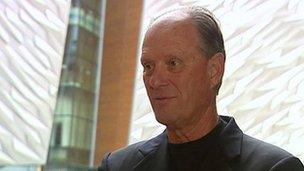Titanic's discoverer Robert Ballard returns to Belfast
- Published
It was the perfect setting for Dr Robert Ballard, the man who found the Titanic.
On his second visit to Northern Ireland, he chatted to a group of young school children under the peeling paint of the Harland and Wolff drawing office in Belfast where, over a century ago, excited draughtsmen came up with the concept of the Titanic.
There was genuine fascination as they listened in awe to how he discovered the ship and became the first person to visit it in over 70 years.
How long did it take to get to the wreck? What is it like in a tiny submarine? They fired question after question and Ballard was in his element.
After all, part of his Titanic follow-up includes an education aimed at encouraging young people towards the sciences.
The explorer was in Belfast making a documentary to mark next year's centenary of Titanic's sinking.
He also visited the new Titanic Signature Project which is still being completed. Next April, it is hoped that live pictures will be beamed there from the wreck of the Titanic itself.
More than a quarter of a century has passed since he found the wreck some 350 miles south east of St Johns in Newfoundland. His name is now synonymous with the Titanic. Did he get a bit fed up with the endless questions about discovering the ship?
"Well, I know it is constantly re-discovered by every generation", he said.
"I find the most useful part of it is the fascination of young people. When we came home from the discovery trip I was surprised to find 16,000 letters on my desk from young people.
"I'm able to use their fascination in the Titanic to get them to be fascinated in science and technology. So I see it as an opportunity to get young people interested in undersea exploration and the science so that they will study a little harder in school."
Our conversation was somewhat dampened by the inevitable Northern Irish drizzle but not before he corrected me on the claims that eventually the ship would end up as a rusty blob on the sea bed.
Images of the stricken vessel show that she has collapsed over the years, some say from being slowly eaten by iron-munching microbes. But he believes that it is a self-serving claim from those who want to bring artefacts back from the wreck before it collapses.
'Amazing ship'

More than a quarter of a century has passed since Dr Robert Ballard found the wreck
"Actually, I find that the greatest damage being done to the Titanic is by visitors. People going down and hitting it with submarines. The submarines are doing far more damage. When cameras have gone deep inside the Titanic, where there is very little oxygen, it is in a high state of preservation, so I think it is going to be there for a long, long, long time."
One thing that visitors to Northern Ireland and especially to Belfast will note is a certain local apathy towards the iconic ship. Some see her simply as a human tragedy with the loss of over 1,500 souls. Hardly a cause for ghoulish fascination.
Others see her as an engineering embarrassment. At one stage, Harland and Wolff staff would decline even to speak of her.
Yet here was the man who discovered her praising the Titanic while under the very roof of former Harland and Wolff property. So I put it to him that, while elsewhere in the world it is regarded as iconic, in Northern Ireland we are still not quite certain how to cope with the ship's loss.
"I'm glad that Belfast is finally proud of having built the Titanic", he explained. "They built an amazing ship. It wasn't their fault that it sank. It was an amazing piece of engineering. So I am really pleased that they are now proud of what they did."
There used to be an old put-down in Belfast if you mentioned the Titanic with any degree of interest. "It sank - get over it!".
But the finishing touches are being put to a £100m building to mark the centenary. It stands in the Titanic Quarter near the centre of Belfast, beside the preserved slipway where the Titanic was launched all those years ago. Beside that is the preserved Thompson Engraving Dock where she was fitted out.
All waiting to greet an anticipated titanic influx of tourists next year. We might just have gotten over it after all.